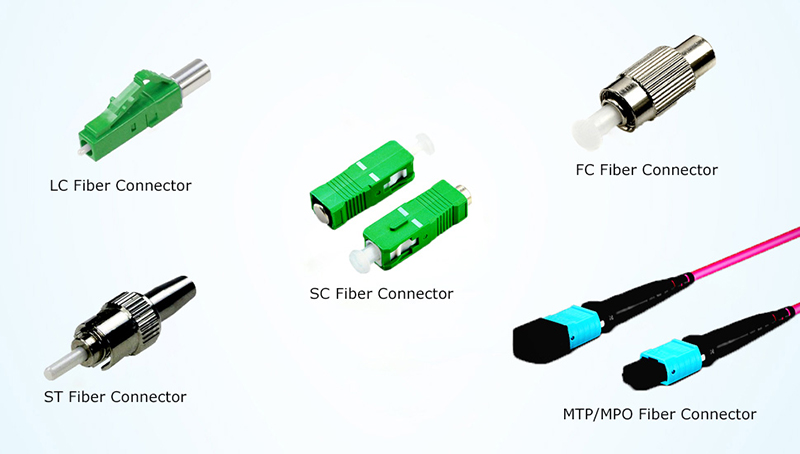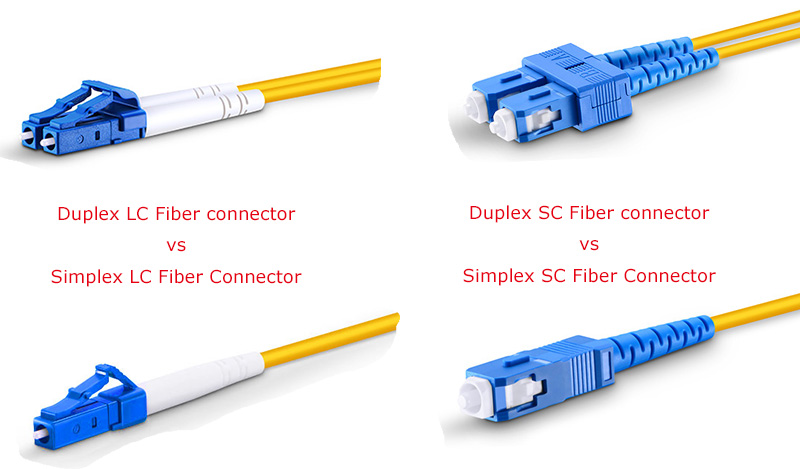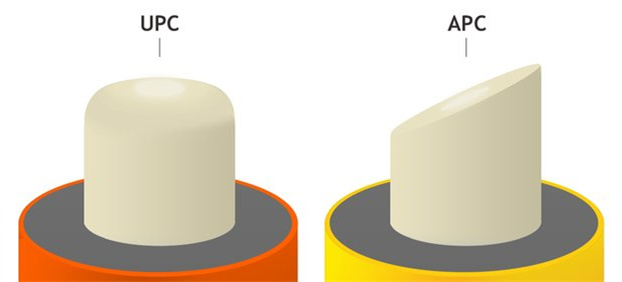Fiber connectors, also called fiber optic cable connectors, are often used to link optical fibers where a connect or disconnect capability is needed. Fiber optic cable connectors come in many configurations and usages, and simplify fiber optic cable installation and maintenance greatly. A number of fiber connector types have been evolved and withstood the test of time to become industry standards. Then how many fiber connector types do you know or use? What are the differences between single mode fiber connector and multimode fiber connector? Find details in the following parts.
Fiber Connector Types Overview
In the present fiber connector market, there are about 100 fiber optic cable connectors in total. And the most commonly used fiber connector types includes LC, SC, MU, ST, FC, MTRJ, NID, E2000 and MTP/MPO connector. However, no matter what the fiber connector types are, they have the same function and similar basic components—ferrule, connector body and coupling device. And these fiber connectors are widely used in the termination of optical fibers like fiber optic pigtails. Here are five common optical cable connectors.

—LC Connector (Lucent Connector)
Developed by Lucent Technologies, the LC fiber optic connector has become the ubiquitous fiber connector for today’s optical telecom applications, especially for connections with SFP and SFP+ fiber transceivers. As one popular SFF (small form factor) connector, LC fiber connector has a ferrule of 1.25mm, which make it perfect for high density cabling. There are single mode LC connector and multimode LC connector. And based on the connector construction, LC connector also can be divided into LC duplex and simplex connector.
—SC Connector
Different from LC connector, SC fiber connectors use a round 2.5mm ferrule to hold a single mode fiber (SMF). And it has a “square shaped” connector body, which is the source of name “square connector”. Due to its excellent performance, fiber optic SC connector remains the second most common connector for polarization maintaining applications. SC fiber connector is ideally suited for datacoms and telecoms applications including point to point and passive optical networking.
—ST Connector
ST fiber connector was created and licensed by AT&T and is still one of the most popular connectors. It has an insertion loss of about 0.25dB and holds the fiber with a ceramic, spring-loaded 2.5mm ferrule that stays in place with a half-twist bayonet mount. ST fiber connector is usually used in both long and short distance applications such as campuses and building multimode fiber applications, corporate network environments and military applications.
—FC Connector
FC fiber connector was the first optical fiber connector to use a ceramic ferrule, but unlike the plastic bodied SC and LC connector, it utilizes a round screw-type fitment made from nickel-plated or stainless steel. The FC connector end face relies on an alignment key for correct insertion and is then tightened into the adaptor/jack using a threaded collet. Despite the additional complexity both in manufacturing and installation, FC connector is still the connector of choice for precise measuring equipment such as OTDRs, as well as the choice for single mode fiber.
—MPO/MTP Fiber Connector
MPO/MTP fiber connector is a multi-fiber connector which combines fibers from 12 to 24 fibers in a single rectangular ferrule. It’s often used in 40G and 100G optical parallel connections. Compared with other fiber connectors mentioned above, MPO/MTP fiber connectors are more complicated. Because there are key-up and key-down, male and female MPO/MTP connectors. As for the confusing problem—MPO fiber connector vs MTP fiber connector, get more details here: MPO/MTP Connector: Difference and Cleaning Recommendation
Simplex vs Duplex Fiber Connector
Simplex connection means signals are sent in one direction. For example, a signal is transmitted through two simplex connectors and a simplex fiber cable from device A to device B. It cannot return from device B to device A via the same route. But the revise transmission can be achieved through duplex connectors and duplex fiber cable, which is called duplex connection. In addition, simplex fiber connector is often connected with one strand of glass or plastic fiber, while duplex fiber connector needs to connect with two strand of fibers. The following picture shows the comparison of LC duplex connector and SC duplex connector.

Fiber Connector Polishing: APC Connector vs UPC Connector
According to the polishing type, optical fiber cable connectors can be divided into APC connector and UPC connector. The main difference lies in APC connector vs UPC connector is the fiber endface. APC fiber connectors have an 8 angle cut in their ferrules, which makes connections between optical fibers very tight. But their return loss can be up to -60dB. While UPC connectors have a convex end-face, but have a finer surface finish. Their return loss goes from -40dB from -55dB, which makes them reliable for transmitting TV and data signals. Besides, the color code for APC fiber connector is green, UPC connector for blue. That’s why we see different colors of LC APC connector, SC APC connector and other fiber connectors.

Single Mode vs Multimode Fiber Connectors
As we have known, the basic difference between single mode and multimode fiber cable is the number of light modes which can be transmitted at a time. Single mode fiber allows only one light mode to pass through at a time. While multimode fiber can propaganda multiple modes at a time. That’s also the basic difference lies in single mode fiber connectors and multimode fiber connectors. Because they are combined with the corresponding type of optical fibers. However, with technologies getting advanced, fiber connectors like SC, LC and FC, provided by fiber optic connector factories are compatible with single mode and multimode fiber cables.
Conclusion
Fiber connectors are small but important components in optical fiber communications. This article mainly discussed about the fiber connector types and some common issues of optical cable connectors. With the wide variety of fiber optic cable connectors available today, users can easily convert to fiber optic networks and start enjoying the benefits of a faster, more efficient work environment. However, no matter what fiber connector types you choose, selecting a reliable fiber connector factory is the first thing you need to do.
Post time: Aug-01-2019
